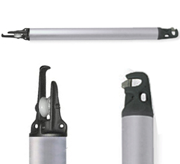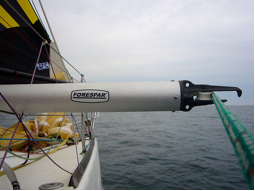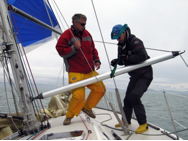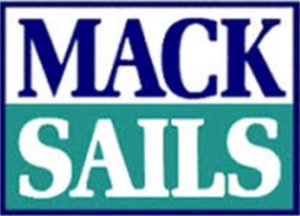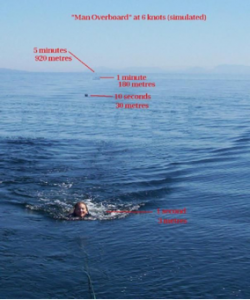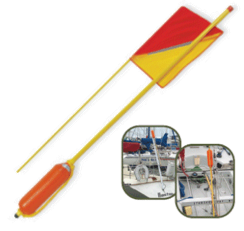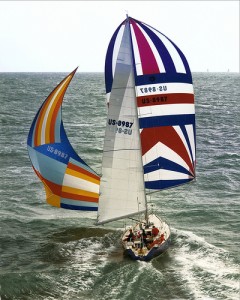Forespar's Point of View
Blogging About Life on the WaterCategory Archives: Forespar Products in Use
Anything With a Swim Step
It’s 2 a.m. You’re on a mooring in your favorite getaway harbor. The party on the boat three cans down has finally died away. And, you still can’t sleep. Something’s missing. You jump up and dash topside, flashlight in hand, looking over the side and around the anchorage. The dinghy got away! It’s not banging on the side at the end of the painter! That’s what’s missing….
You glance over the transom, and there she is, firmly clipped to the swim step. Not swinging, not banging on the side, not trying to escape. Easy to board, easy to release, and easy to attach and exit. That’s a side benefit of the Forespar Quik Davit. 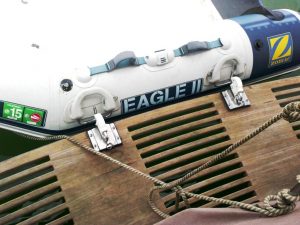
We added the Quik Davit to the swimstep of our Grand Banks so we’d have an easy way to hoist in the dinghy when moving to a new spot, rather than use the the topside power hoist, etc. It works perfectly as the name implies, and as our private, mobile dinghy dock.
Friends use the Quik Davit on a variety of smaller and larger power boats as the primary davit because it’s easier to inflate the dinghy at the home dock, hoist/tilt it onto the step, and drive away – and reverse the process when back at the home dock. Sailboat owners do the same, usually for shorter cruises, and for the above-mentioned reason.
Check Quik Davit out. It installs easily on both the dinghy and the step of just about any boat, is easy to use, the price is right – And you’ll sleep better.
Single-Handed Spinnaker Sailing
We all like spinnaker sailing, but seldom try it single-handed. Take this lesson, but remember that he’s using auto helm for his tiller. If you’re sailing in a smaller to medium boat in light or low-moderate air (under 12 knots), this will work. Any stronger breeze, especially at sea, and single handed kite flying will get “varsity” in a hurry.
What’s a Spinnaker Strut?
And Why Do You Need One?
A spinnaker strut is a relatively short (usually aluminum) pole with one end fitting designed for mast attachment, and the other for running a line across a small internal pulley. Standard sizes range up to about seven feet in length and three or four inches in diameter. They look like this:
As its name implies, the strut is for use with a traditional symmetrical spinnaker. It will keep the afterguy (or the spin sheet you’re using as an afterguy) attached to the spinnaker pole away from lifelines, stanchions and other undesirable points on its way back to the stern.
The strut is usually attached to the mast via a padeye on the mast, and often held in position with a sail tie to a shroud
Sailors want a reaching strut because:
- With the afterguy riding across the sheave in the end of the strut, the pole is much easier to control and adjust. Eliminating the friction is important.
- The line will chafe as it rides across the lifeline, stanchions, etc. Decent line for sheets and guys starts at about 75 cents a running foot, and the good stuff at twice that. Unnecessarily replacing it gets old in a hurry.
- The load on the afterguy can be significant if it’s blowing. That can and will bend the lifeline and stanchions.
- Crew on the rail will be safer and happier without a loaded (and possibly weak) guy on their chests or backs.
And, more important – when sailing fairly close to the wind with the spinnaker, the pole is well forward. In a good breeze the afterguy or sheet is very heavily loaded. If that lifeline or stanchion (or both) bends enough, or breaks, the pole will slam forward into the forestay. Bad things can happen. Very bad things.
A reaching strut is easy to rig, and easy to use. Because it’s fairly short, it’s also easy to stow. And not expensive , especially when you consider the cost of a forestay or mast.
Mack Sails & Forespar – A Solid Combo
Something Big This Way Commeth …
when in 1967 Swedish Sailmakers, a Fort Lauderdale fledgling sailmaking firm, partnered with lifelong sailor Brad Mack and Bradford Mack & Co was launched. For the next 20 years, the company continued to expand and in 1988 moved to Stuart, FL and was renamed Mack Sails. Over the years the company has expanded to include a full service rigging shop and a complete marine electronics service . Every Mack Sail is made in Stuart, FL and “…we insist that each one is made from the very best cloth and hardware.”
Brad Mack’s two sons, Travis Blain and Colin Mack , grew up in sail boats racing, cruising, or in the sail loft “learning the ropes.” After college Travis and Colin officially joined the firm and in 2002, took the helm, sharing the management and striving to deliver an extraordinarily designed and crafted product.
Colin and Travis remember the old days when they were ‘sponges’ learning everything possible at a rapid fire pace. “The lessons have all paid off because without the encouragement and guidance of our dad, the company could never have become what it has today.”
For close to 50 years the family tradition of pride and commitment to quality service sets Mack Sails apart based on these standards:
- Pride in every sail we manufacture – all designed for speed and durability
- Only the highest quality U.S. woven and finished cloth and tapes are used in our sails
- Hands on customer service begins with the initial contact and continues all the way through sail and rigging delivery and installation
Strong relationships have played a significant role in Mack Sails’ growth. In 1967, a key affiliation with Forespar began when Brad reached out across the U.S. for like-minded entrepreneurs who held similar strong business and family values. For the next 40 plus years, the Mack Sails and Forespar® relationship thrived and remains an industry symbol of ‘partnering for progress’ for both entities.
What the collaboration with Forespar stands for is simple, according to Travis. Mack Sails has worked with them on many projects (one of the first hydraulic Leisure Furl™ booms – aluminum or carbon fiber booms offer safety and convenience of In-Boom mainsail reefing and furling systems from the safety of the cockpit .)
“Collectively, we pooled resources and were the first ever to design and install a large roached full batten main for a Leisure Furl™ boom furling system on a Lagoon 440,” said Travis.
Colin says, “Throughout this journey, we’ve blended excellent products and service that satisfies the most demanding and rigorous standards that sailors demand. Forespar makes the boom furlers, and we make the sails and install them (riggers and sailmakers). This collaboration extends beyond the U.S., with LeisureFurl installations most recently as far away as Italy and Trinidad.”
“Forespar has developed a very good LeisureFurl™ design that allows Mack Sails no restrictions on multi-hulls; because of that we sell more of their booms and we install the boom systems and sails in sync, ” Colin concluded.
Forespar Vice President Bill Hanna sees the strong bond between both companies as a significant advantage to Forespar’s success over the years. “Though they are located in Florida, the Mack Sails team is always a phone call away…it’s as if they were in the office right next door. Our collaborations have become almost seamless because we’ve shared building and delivering quality boom systems, sails and rigging for nearly 50 years!”
Mike Dwight
Overboard at Night
Overboard at Night – Newport to Ensenada Race
A Farr 40 was doing about 15 knots downwind in a 20-knot breeze. It was Friday night about 8pm, after the noon start, and they were just off the Coronado Islands. Good breeze, good speed. and about halfway down the course. Great N2E race so far.
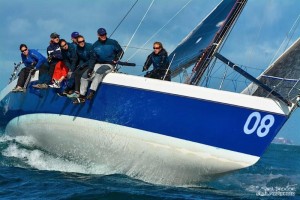 Large wave slaps the stern, causing an ugly round down. One of the crew slip under the lifeline and into the sea. No harness, no leash, and no PFD or light on him or four of the other five crew. On top of that, he broke his arm badly on the way over the side.
Large wave slaps the stern, causing an ugly round down. One of the crew slip under the lifeline and into the sea. No harness, no leash, and no PFD or light on him or four of the other five crew. On top of that, he broke his arm badly on the way over the side.
The only crew wearing a PFD grabs the tiller, and she gets the boat back up. About 500 yards later, they’ve got the boat back under control and the kite back in the boat. They get the engine started, and head back upwind in 20+ knots and fairly big waves looking for their lost guy.
They found him.
Why? They did some things right. While one sailor launched the Man Overboard gear, another kept pointing at the spot where he hit the water. The MOB pole was lighted, and a float was part of that gear. And they launched it in a timely manner, enabling the swimmer to get to it under difficult (to say the least) conditions. After wrestling with an injured sailor (a 200-pound man, with one usable arm, wearing wet foulies) and the Life Sling, they got him aboard. And, yes, the Coast Guard helo did show, but it was easier to abandon the race and get him to San Diego than deal with an air rescue off a sailboat in the wind and sea conditions.
When was the last time we heard about someone going over the side under those circumstances, and being found, much less alive? Kudos to the Foil crew for reacting well in a bad situation.
I’m serious about that kind of safety – jack lines, harnesses, etc. The crew on my boat get a little peeved when I insist on all that stuff after dark, especially when it’s bumpy out there. Wear it, and rig it. And make sure you’ve got good MOB gear and know how use it. You may never need it, and let’s hope that’s the case, but when you do, it saves a life!
Mike Dwight
What’s The Yellow Pole with the Orange Flag?
That head in the water is getting away from you at 10 feet per second, and you’re only going six knots. So, in the five seconds it takes you to react, she’s already 55 feet away. 10 seconds, she’s 110 feet astern. If there’s any kind of sea running or a foot of chop, how long before you lose sight of that head, life jacket or not?
Just for training, wad up a paper bag or some wrapping paper, or blow up a balloon to about the size of your head. Toss it over side when you’re under way, and time yourself. It can be hard to find.
That’s why savvy sailors have that yellow pole with the orange cylinder at the base up along the rigging at the back of the boat. It’s a MOB (Man Over Board) pole.
The MOB pole is attached to the stern pulpit at the base, and to the backstay, enclosing the flag at the top. 50 or more feet of line (yellow) is tied to the float on the pole, and the other end to your horseshoe buoy. The picture below shows the basic pole in two parts for shipping, and how it might be mounted.
Deploying the pole is simple – a quick reach back from the helm, lift the pole from its seat, and drop it, reach over, and throw the horseshoe – not necessarily in that order – as long as it’s done quickly.
Now, there’s a high-visibility flag and pole six to ten feet high in the immediate vicinity of your overboard crew. The skipper and crew can track the person the water using the flag, making it much easier to take in sail and get the boat around and back to that flag. You will come up on the windward side of the flag, grab the pole, and reel in the horse shoe with the errant crew member.
A number of sailboats, particularly racers, have an installed horizontal tube, open at the transom. The pole in inserted flag end first, with the line coming out of the transom to the horseshoe. The horseshoe is thrown, and the resulting drag pulls the pole out toward the person in the water.
Many skippers attach a light to the pole. You may not see the pole/flag at night, but you will see the light. Obviously a good idea, and one we’ve used for years of cruising and offshore racing.
Get the pole and install it. You may never need to use it, but if you do, you will need it.
Mike Dwight
Bloopers
Ocean racing is just about to become more colorful – again!
The new ORR rules are allowing bloopers on non-sprit boats (with some restrictions). For sailors who don’t remember, look at the picture, and check out the big sail tacked to the port bow.
Look at the wake, and the waves, and realize just how deep and fast they’re sailing. Pole back a bit, ease the main a bit, and trim on the the blooper and that boat is still launched – even dead down wind. In light and moderate air, you’ve got a big downwind sail you trim with the halyard. You’ll want a racing crew with someone who either has or can develop a different set of trimming skill, but you’ll make up for it with VMG and boat speed. That blooper helps narrow the gap between an older boat and the sprit boats.
We’ll see them this year on the ocean races such as Bermuda, Transpac and Mackinac.
The ORR rule limits blooper use by treating the blooper as headsail (no pole), and within the number of sails the boat is allowed to carry. It has to be attached to the bow, and there are restraints on the boats allowed to fly them, as in basic design from before 1986. And couple of cautions: Think oscillations. Think about a little too much breeze and an interesting round up or crash jibe.
On the other hand, think speed.
Mike Dwight
By Sailors and For Sailors
Some time there’s a good idea that goes quietly unnoticed except for the insiders. Here’s case in point:
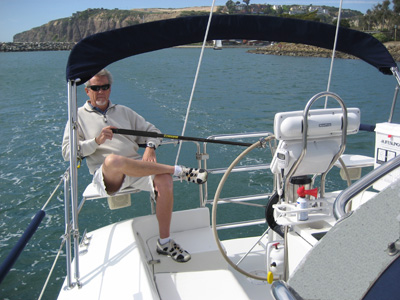
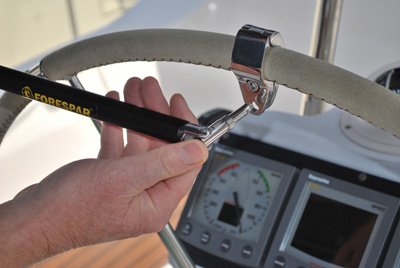
A steering control arm. You want sit comfortably alongside the wheel, where you can see better, and steer with your fingertips. Or you want to get on the rail because its blowing a bit, you want the weight change as well as a better look the the sails.
A quick push button connector lets you attached the arm to your wheel, and when it’s time for real wheel steering, with a couple of seconds it’s off. Better yet, it extends with a twist lock
For that long reach or tack, especially on an lazy day, the steering control arm is just the ticket for a easy sail.
Mike Dwight
Forespar Marelon Plumbing Honored

We are very honored and excited to have been named the 2015 recipient of the Fisheries Supply InNEWvation award in the Plumbing category! Pictured are our own designers John Dean and Art Bandy with the award-winning ClearView End Fittings. Forespar’s composite boat plumbing features the full line of Marelon, from seals and fitting to a full array of valves.
Mike Dwight
